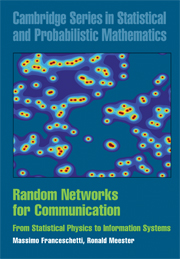Crossref Citations
This Book has been
cited by the following publications. This list is generated based on data provided by Crossref.
Anandkumar, A.
Swami, A.
Yukich, J.E.
and
Lang Tong
2009.
Energy scaling laws for distributed inference in random fusion networks.
IEEE Journal on Selected Areas in Communications,
Vol. 27,
Issue. 7,
p.
1203.
Grindrod, Peter
and
Higham, Desmond J.
2010.
Evolving graphs: dynamical models, inverse problems and propagation.
Proceedings of the Royal Society A: Mathematical, Physical and Engineering Sciences,
Vol. 466,
Issue. 2115,
p.
753.
Shariatpanahi, Seyed Pooya
and
Hossein Khalaj, Babak
2010.
A novel approach to power allocation in wireless ad hoc networks.
p.
77.
Eslami, A.
Nekoui, M.
and
Pishro-Nik, H.
2010.
Results on Finite Wireless Networks on a Line.
IEEE Transactions on Communications,
Vol. 58,
Issue. 8,
p.
2204.
Ao, Weng Chon
Cheng, Shin-Ming
and
Chen, Kwang-Cheng
2010.
Phase Transition Diagram for Underlay Heterogeneous Cognitive Radio Networks.
p.
1.
Eslami, A.
Nekoui, M.
and
Pishro-Nik, H.
2010.
Results on finite wireless networks on a line.
p.
1.
Coon, Justin
Dettmann, Carl P.
and
Georgiou, Orestis
2012.
Impact of boundaries on fully connected random geometric networks.
Physical Review E,
Vol. 85,
Issue. 1,
Ao, Weng Chon
and
Chen, Kwang-Cheng
2012.
Cognitive Radio-Enabled Network-Based Cooperation: From a Connectivity Perspective.
IEEE Journal on Selected Areas in Communications,
Vol. 30,
Issue. 10,
p.
1969.
Torrieri, Don
and
Valenti, Matthew C.
2012.
The Outage Probability of a Finite Ad Hoc Network in Nakagami Fading.
IEEE Transactions on Communications,
Vol. 60,
Issue. 11,
p.
3509.
Liang, Junhua
and
Zhang, Wenjun
2012.
Statistic Properties of Highway Systems in Wireless Networks: A Random Line Process Viewpoint.
p.
1.
Chau, Chi-Kin
Gibbens, Richard J.
and
Towsley, Don
2012.
Impact of directional transmission in large-scale multi-hop wireless ad hoc networks.
p.
522.
Thiedmann, Ralf
Gaiselmann, Gerd
Lehnert, Werner
and
Schmidt, Volker
2012.
Fuel Cell Science and Engineering.
p.
669.
Weng Chon Ao
and
Kwang-Cheng Chen
2012.
Bounds and Exact Mean Node Degree and Node Isolation Probability in Interference-Limited Wireless Ad Hoc Networks With General Fading.
IEEE Transactions on Vehicular Technology,
Vol. 61,
Issue. 5,
p.
2342.
Ao, Weng Chon
Cheng, Shin-Ming
and
Chen, Kwang-Cheng
2012.
Connectivity of Multiple Cooperative Cognitive Radio Ad Hoc Networks.
IEEE Journal on Selected Areas in Communications,
Vol. 30,
Issue. 2,
p.
263.
2013.
Stochastic Geometry and its Applications.
p.
453.
Eslami, Ali
Nekoui, Mohammad
Pishro-Nik, Hossein
and
Fekri, Faramarz
2013.
Results on finite wireless sensor networks.
ACM Transactions on Sensor Networks,
Vol. 9,
Issue. 4,
p.
1.
Liu, Ziyang
Peng, Tao
Chen, Hao
and
Wang, Wenbo
2013.
Transmission Capacity of D2D Communication under Heterogeneous Networks with Multi-Bands.
p.
1.
Pin-Yu Chen
Shin-Ming Cheng
and
Kwang-Cheng Chen
2014.
Information Fusion to Defend Intentional Attack in Internet of Things.
IEEE Internet of Things Journal,
Vol. 1,
Issue. 4,
p.
337.
Bradonjić, M.
Hyman, J.M.
Milner, F.
and
Saldaña, J.
2014.
Outbreak of Infectious Diseases through the Weighted Random Connection Model.
Mathematical Modelling of Natural Phenomena,
Vol. 9,
Issue. 2,
p.
82.
Gupta, Bhupendra
and
Lamba, Subir Singh
2014.
On k-th nearest neighbor distance distribution of random ad-hoc network.
p.
518.



